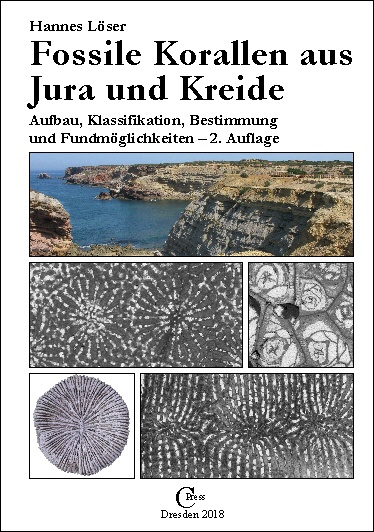
|
Hannes LöserJurassic and Cretaceous Corals - Morphology, classification, determination, and localitiesFossile Korallen aus Jura und Kreide – Aufbau, Klassifikation, Bestimmung und Fundmöglichkeiten
Second edition.
CPress Verlag Dresden
|

|
Hannes LöserJurassic and Cretaceous Corals - Morphology, classification, determination, and localitiesFossile Korallen aus Jura und Kreide – Aufbau, Klassifikation, Bestimmung und Fundmöglichkeiten
Second edition.
CPress Verlag Dresden
|
      |
Coral reefs are complex ecosystems. Their main producers - the corals - are more primitive organisms.
Nevertheless they create complicated constructed skeletons presenting a wide range of shapes. For half a billion years exist corals, for about 250 million years the stony corals (Scleractinia) which colonize also today oceans. Changing environmental conditions forced the sensible organisms to create again and again new constructions resulting in a almost unlimited richness of forms through time. Not much is known about the relationship between the construction of the skeleton made of calcium carbonate and the biology of the living animal, mainly for groups which lived in periods long ago making classification and taxonomy difficult.
This book will be help to work with Mesozoic corals (without Triassic) and gives in five large chapters (morphology; palaeoecology, diversity and evolution; sampling and examination; systematics and list of common genera; coral localities) insight in the most important aspects of a difficult organism group. The book is based on lecture material and is written for geology and biology students, as well for interested amateurs and biologists or geologists who want to gain insight in this invertebrate group. Much just recently published data on systematics, diversity and taxonomy makes the book up to date and might be interesting also for specialists. Second edition. The systematic part is completely new. The key tables are more simple and clear, and for the genus level more complete. More than the half of the figures in the systematic part were replaced by better images. Some more genera are included. Contents (PDF, second edition)

They are examples for the development of certain characteristics such as the wall, perforation of septa etc. |
|
Orders : CPress Verlag, Max-Schwarze-Str. 36, 01257 Dresden Fax +49 (0) 3212 1007315 E-Mail: 
|
[15 February 2018]